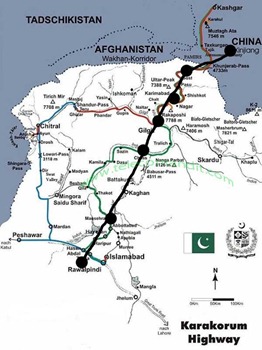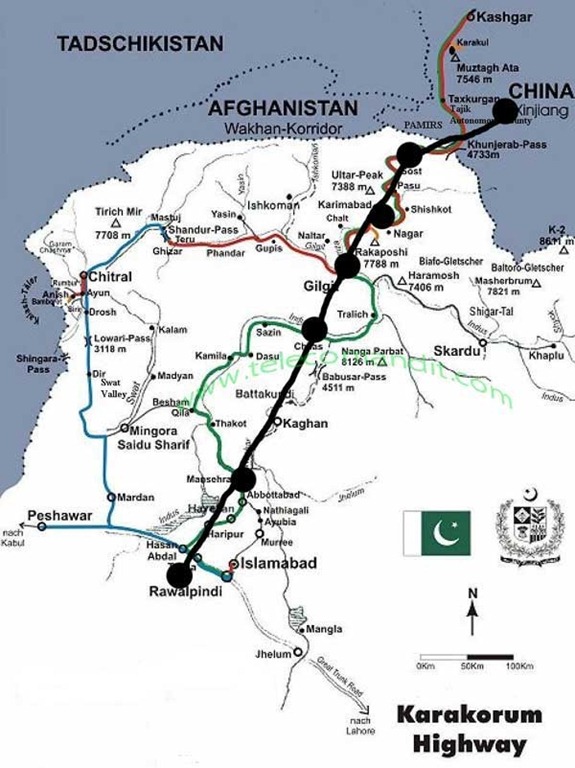
This mega telecom project will cost Rs. 3.7 billion and will accrue economic benefits to Pakistan and will establish alternate international connectivity with China, Central Asian Republics (CARS) and Europe.
At present, Pakistan’s international connectivity with the world is through undersea cables, that are SEA-ME-WE 3&4, IMEWE and TWA-1, and Pakistan is connected through spurs only.
On completion, the project will also facilitate trade, tourism and IT awareness in the region and generate economic opportunities particularly in Gilgit-Baltistan.
This cross-border fiber link is expected to generate revenue, approximately Rs 1.5 billion in the first three years and, in the fourth year, the financial dividends are likely to grow.
Project is result of a Memorandum of Understanding (MoU) that was signed in April 2007, while construction and Maintenance Agreement between SCO and China Telecom (CT) was signed during the visit of Chinese Vice Premier to Pakistan in Jun 2010.
SCO persistently pursued the process for its approval and the project was finally approved by the Government of Pakistan in Dec 2010.
Launch ceremony for this project was held in HQ SCO. Director Development of HQ SCO gave a detailed briefing on technical aspects of the project and invited technical proposals from the firms for the execution of the project.
Chairman SCO Project Management Board IGC&IT, SO-in-C, DG SCO, Member Telecom MoIT, and CEOs/Representatives of all Chinese telecom firms were also present at the occasion.


























Slight Correction: Pakistan is also connected internationally via TWA-1 cable operated by Transworld Associates. It is the need of the hour for the government to relax regulations so border interconnects can be established with all neighboring countries.
Yippie, already depressed prices are going to fall further. The customer will prosper in the short run though. In the long run, we arent sure what will happen!
Yes true, but it would make sense if volume grows more than the price decline, with more broadband connectivity bandwidth demand is set to increase although with all projections we sometimes fail to integrate the component of poor literacy in our country which significantly hinders broadband proliferation and demand
All the talk about lower rates doesn’t make a lot of sense to be honest. Look at all the websites you visit. How many are hosted in east Asia or in China? I can’t think of a single one. The shortest path to most of the websites people in Pakistan use is to the west.
When it comes to bringing content closer, companies like akamai and google have caches near us (located inside Pakistan or in nearby countries). They’re already close enough that a link to China won’t make a difference.
End result: even if traffic through China link makes overall prices go down, all traffic that goes through China will take a longer route to the most trafficed web sites people use.
@saleem
Technology is not my profession but i think there is a difference between low latency and high speed. You may get a lower latency by having shorter interconnects but not necessarily higher speed. Frankly speaking the most pings takes <500ms and consider the average time a page or a video takes to load. The time it takes to buffer a video is not dependant on latency but on the speed of the connection. So high latency is not good for voip but it will have little or no effect on websites/videos/torrent/download etc
Yes, once you start a download, the speed is the issue. But for browsing, latency is a big problem. For example, if you use chrome and its inspector, you can use the “network” tab to see how long it takes to download all the assets for a web page (javascript, etc). They don’t even start until the first page is loaded. Then, for moderately heavy sites (like wordpress blogs) there are lots of files to download and the browser only makes a fixed number of connections at a time.
It adds up. Especially consider how much ajax is used these days. Each ajax call is latency (hundreds of ms) + action on server (usually under 50ms or 0.05 seconds). If every event is going to take (example) 300ms + 20ms to do (0.32 seconds), the web is slow. But you never experience it because you have never experienced low latency! Whereas an ordinary person living in West will generally experience latency of under 100 ms. So, same operation is 90ms + 20ms = 0.11 seconds. In the time it takes you to do three operations (1 second), they can do almost 11 operations.
Now this a news that qualifies to the standard of propakistani unlike news about terrifs & packages